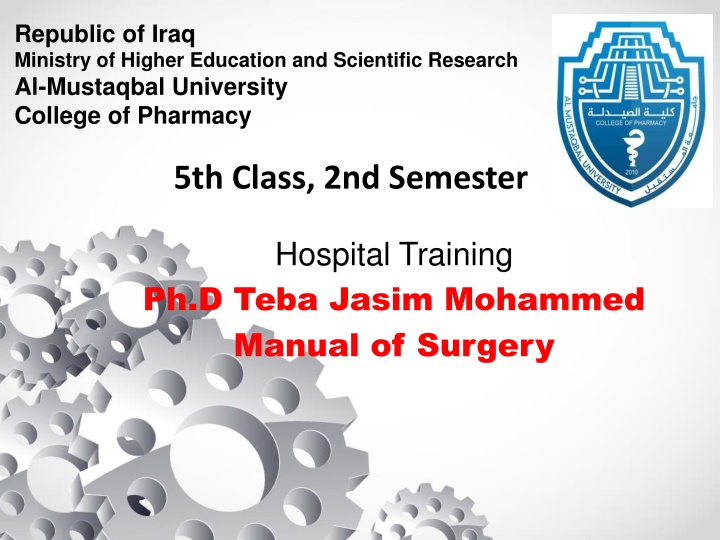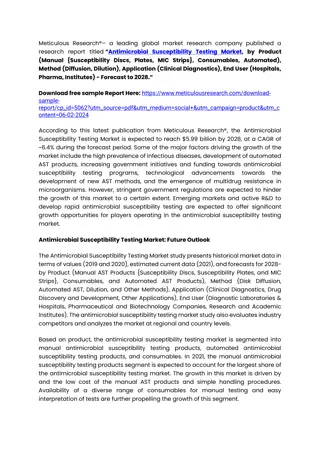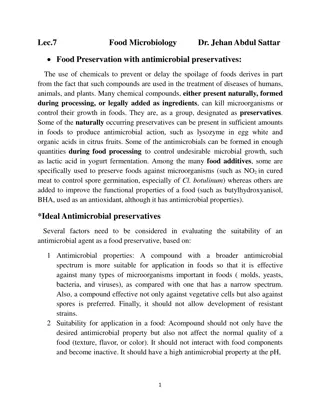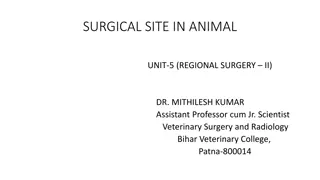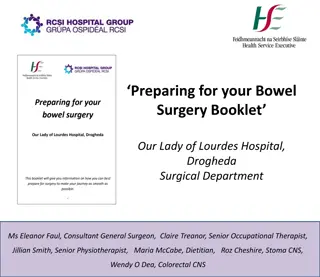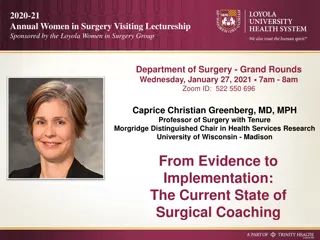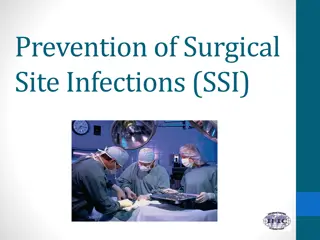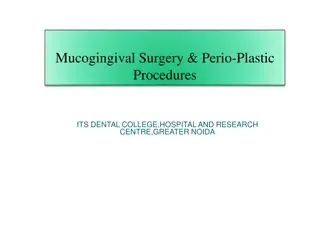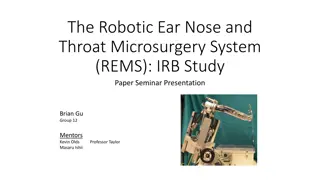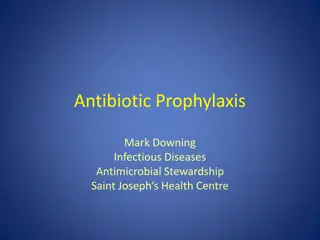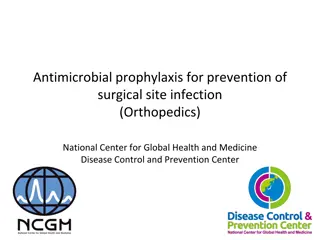Surgical Prophylaxis and Antimicrobial Selection Guidelines in Surgery
Surgical prophylaxis involves administering antibiotics before contamination of previously sterile tissues to prevent infections. Common pathogens in surgical site infections include skin flora like S. aureus. Antimicrobial selection is based on the surgical procedure, likely pathogens, and safety considerations. First-generation cephalosporins are commonly used for gram-positive coverage, while vancomycin may be considered for MRSA coverage in prosthetic implant surgeries.
Download Presentation

Please find below an Image/Link to download the presentation.
The content on the website is provided AS IS for your information and personal use only. It may not be sold, licensed, or shared on other websites without obtaining consent from the author.If you encounter any issues during the download, it is possible that the publisher has removed the file from their server.
You are allowed to download the files provided on this website for personal or commercial use, subject to the condition that they are used lawfully. All files are the property of their respective owners.
The content on the website is provided AS IS for your information and personal use only. It may not be sold, licensed, or shared on other websites without obtaining consent from the author.
E N D
Presentation Transcript
Republic of Iraq Ministry of Higher Education and Scientific Research Al-Mustaqbal University College of Pharmacy 5th Class, 2nd Semester Hospital Training Ph.D Teba Jasim Mohammed Manual of Surgery
Surgical prophylaxis: Antibiotics administered before contamination of previously sterile tissues or fluids are considered prophylactic. The goal of prophylactic antibiotics is to prevent an infection from developing Common surgical pathogens *The predominant organisms causing SSIs after clean procedures are skin flora, including S. aureus and coagulase-negative staphylococci (e.g.,Staphylococcus epidermidis) *In clean-contaminated procedures, including abdominal procedures and heart, kidney, and liver transplantations, the predominant organisms include gram negative rods and enterococci in addition to skin flora
Antimicrobial selection The choice of the prophylactic antimicrobial depends on the type of surgical procedure, most likely pathogenic organisms, safety and efficacy of the antimicrobial,Typically, gram-positive coverage is included in the choice of surgical prophylaxis because organisms such as S. aureus and S. epidermidis are common skin flora. Parenteral antibiotic administration is favored because of its reliability in achieving suitable tissue concentrations. First-generation cephalosporins (particularly cefazolin) are the preferred choice. Antianaerobic cephalosporins (eg, cefoxitin or cefotetan) are appropriate choices when broad-spectrum anaerobic and gram negative coverage is desired. Vancomycin may be considered for prophylactic therapy in surgical procedures involving implantation of a prosthetic device in which the rate of methicillin-resistant S. aureus (MRSA) is high. If the risk of MRSA is low and a -lactam hypersensitivity exists, clindamycin can be used instead of cefazolin in order to limit vancomycin use.
Types of Surgical Operations 1- Clean : An uninfected operative wound in which no inflammation is encountered and the respiratory, alimentary, genital, or uninfected urinary tracts are not entered drainage. ABs Low Not indicated unless high- risk procedure 2- Clean- contaminated: Operative wounds in which the respiratory, alimentary, genital, or urinary tracts are entered under controlled conditions and without unusual contamination. Specifically, operations involving the biliary tract, appendix, vagina, and oropharynx are included in this category. Medium Prophylactic antibiotics indicated 3- Contaminated Open, fresh, accidental wounds. In addition, operations with major breaks in sterile technique (e.g., open cardiac massage) Technique break during clean- contaminated. procedure. High Prophylactic antibiotics indicated 4- Dirty Obvious preexisting infection present(abscess, pus, or necrotic tissue present).Therapeutic antibiotics requir
Principles of Antimicrobial Prophylaxis 1-Route of Administration :Intravenous administration is preferred because it produces a more reliable and predictable serum and tissue concentration than intramuscular administration, with the exception of ophthalmic surgery where topical administration is the preferred route. Serum antibiotic levels after oral administration depend on the rate of absorption from the gastrointestinal tract which varies between individuals and is therefore not reliable .But oral administration is used in some bowel operations. Non-absorbable compounds like erythromycin base and neomycin are given up to 24 hours prior to surgery to reduce microbial concentrations in the bowel. Note that oral agents are used adjunctively and do not replace IV agents 2-Timing of First Dose: Most guidelines recommend administration of the antibiotic within 60 minutes of skin incision Administration times closer to incision may possibly decrease the risk of SSI for certain procedures.Exceptions to this guideline are made for the fluoroquinolones and glycopeptides (e.g. vancomycin) which should be started 120 minutes before skin incision due to the need to administer them as an infusion over one to two hours (7), and also to avoid infusion-related reactions. Beginning the infusion after the first incision is of little value in preventing SSI
3-Dosing and Redosing: The goal of antimicrobial dosing for surgical prophylaxis is to maintain antibiotic concentrations above the MIC of suspected organisms for the duration of the operation . If an operation exceeds two half- lives of the selected antimicrobial, then another dose should be administered. Repeat dosing has been shown to lower rates of SSI. 4-Duration: The National Surgical Infection Prevention Project and published evidence suggest that the continuation of antimicrobial prophylaxis beyond wound closure is unnecessary. The duration of antimicrobial prophylaxis should not exceed 24 hours (24-48 hours for cardiothoracic surgery). Combination antimicrobial therapy Combinations of antimicrobials are generally used to broaden the spectrum of coverage for empiric therapy, achieve synergistic activity against the infecting organism, and prevent the emergence of resistance. Disadvantages of Combination Therapy including increased cost, greater risk of drug toxicity, and superinfection with even more resistant bacteria
Thromboprophylaxis Deep venous thrombosis (DVT) is most common in patients over 40 years of age who undergo major surgery. A postoperative increase in platelets coupled with venous endothelial trauma and stasis all contribute. If no prophylaxis is given, 30% of these patients will develop DVT and 0.1-0.2% will die from pulmonary thromboembolism (PTE) Types of thromboprophylaxis 1-Mechanical devices: Thromboembolic deterrent stockings (TEDS). 2-Drugs acting on the clotting cascade: Heparin and Low molecular weight heparin (LMWH). Regimen heparin 5000U SC 2h pre-op, then every 8-12h SC for 7d or until ambulant. Low molecular weight heparin (LMWH, eg enoxaparin 20mg/24h SC, increased to 40mg for high-risk patients, starting 12h pre-op). Fondaparinux (a factor Xa inhibitor) reduces risk of DVT over LMWH without increasing the risk of bleeding.
Risk Groups All patients are -at risk of developing deep vein thrombosis just as is the general population. National requirements for VTE prophylaxis require all patients to be assessed for risk factors on admission and after 24h in hospital. Risk is judged according to: Procedure factors. Prolonged anesthetic time, lower limb or pelvic surgery. Patient factors. Immobility, malignancy, age, dehydration, obesity, diabetes, cardiorespiratory disease, inflammatory pathologies, oral contraceptive pill or hormone replacement therapy (HRT), past or family history of thromboembolic disease. Balanced against: Bleeding risks. Active bleeding, stroke, invasive procedures, bleeding disorders (liver disease, thrombocytopenia, inherited disorders). Risks of compression devices. Peripheral vascular disease (PVD
Preoperative bowel preparation A-Elective colon operation: The human colon and distal small intestine contain a numerous reservoir of aerobic and anaerobic bacteria that are excluded from the body by a mucous membrane barrier, if this barrier is disturbed by disease, trauma, or if the colon is opened to the peritoneal cavity during operation, bacteria may escape into adjacent tissues and causes serious infection, this risk can be minimized by two ways: 1-Mechanical preparation: This is done by one or both of the following procedures: A-Whole gut lavage with an electrolyte solution, mannitol 10%, or poly ethylene glycol the day before surgery. B-Standard mechanical cleansing, which utilizes dietary restriction, catheters, and sometimes enemas 1- 2 days before the operation. 2-Antibiotic preparation:Either oral or parenteral antibiotic
Two oral regimens are now used: A- An aminoglycoside with erythromycin base. B- An aminoglycoside with metronidazole. Parenteral regimen That is now used is cefoxitin IV before induction of anesthesia. Combination of parenteral and oral antibiotics show low incidence of infection B-Emergency colon preparation: 1- Intraoperative lavage performed by introducing of saline in the colon through balloon catheter. 2- Parenteral antibiotic, they should be given IV shortly before operation and continues for 1-7 days postoperatively.
Intravenous fluid therapy Are given if sufficient fluids cannot be given orally. About 2500mL fluid containing roughly 100mmol Na+ and 70mmol K+ per 24h are required. Special cases Acute blood loss Resuscitate with colloid or 0.9% saline via large-bore cannulae until blood isavailable. Children Use dextrose-saline for fluid maintenance: 100mL/kg for the first 10kg, 50mL/kg for the next 10kg, and 20mL/kg there after all per 24h. Elderly More prone to fluid overload, so use IV fluids with care. GI losses (diarrhoea, vomiting, NG tubes, etc) Replace lost K+ as well as lost fluid volume. Heart failure Use IV fluids with care to avoid fluid overload. Liver failure Patients often have a raised total body sodium, so use salt-poor albumin or blood for resuscitation, and avoid 0.9% saline for maintenance. Acute pancreatitis Aggressive fluid resuscitation is required due to large amounts of sequestered third space fluid.
Poor urine output Aim for >1 mL/kg/h; the minimum is >0.5mL/kg/h. Give a fluid challenge, eg 500mL 0.9% saline over 1h (or half this volume in heart failure or the elderly), and recheck the urine output. If not catheterized, exclude retention; if catheterized, ensure the catheter is not blocked Post-operative Check the operation notes for intraoperative losses, and ensure you chart and replace added losses from drains, etc. Shock Resuscitate with colloid or 0.9% saline via large-bore cannulae. Identify the type of shock. Transpiration losses (fever, burns) Be ware the large amounts of fluid that can be lost unseen through transpiration. Severe burns in particular may require aggressive fluid resuscitation
Surgery in those on steroids Patients on steroids may not be able to mount an appropriate adrenal response to meet the stress of surgery due to suppression of the hypothalamic-pituitary- adrenal (HPA) axis. Extra corticosteroid cover may be required, depending on the type of surgery. Consider cover for any patient taking >5mg/d of prednisolone (or equivalent) for more than 2 weeks or any patient who has had their long-term steroid reduced in the last 2 4 weeks. There is also potential for HPA suppression in patients taking long-term high-dose inhaled or topical corticosteroids. Patients should take their normal morning steroid dose. Minor procedures: under local anaesthetic: No supplementation required. Moderate procedures: (eg joint replacement) Give 50mg hydrocortisone before induction and 25mg every 8h for 24h. Resume normal dose thereafter Major surgery: Give 100mg hydrocortisone before induction and 50mg every 8h for 24h. After 24h, halve this dose each day until the level of maintenance. Patients with primary adrenal insufficiency will need extra cover. The major risk with adrenal insufficiency is hypotension, so if this is encountered without an obvious cause, consider a stat dose of hydrocortisone.
Drugs most commonly used in surgical Operation Drugs most commonly used in surgical Operation Tramadol hydrochloride An opioid analgesic indicated for Moderate to severe pain, Moderate to severe acute pain, Moderate to severe chronic pain and postoperative pain. It produces analgesia by two mechanisms: an opioid effect and an enhancement of serotonergic and adrenergic pathways. It has fewer of the typical opioid side- effects (notably, less respiratory depression, less constipation and less addiction potential); psychiatric reactions have been reported. SIDE-EFFECTS : Common or very common : Malaise. Acetaminophen (Paracetamol) A Non-opioid analgesic indicated for Mild to moderate pain or Pyrexia. Ranitidine :A H2-receptor antagonist heal gastric and duodenal ulcers by reducing gastric acid output as a result of histamine H2-receptor blockade; also used to relieve symptoms of gastro-esophageal reflux disease.
Omeprazole A proton pump inhibitor inhibits gastric acid secretion by blocking the hydrogen- potassium adenosine triphosphatase enzyme system (the proton pump ) of the gastric parietal cell. It is effective short-term treatment for gastric and duodenal ulcers; also used in combination with antibacterials for the eradication of Helicobacter pylori. Following endoscopic treatment of severe peptic ulcer bleeding, an intravenous, high-dose proton pump inhibitor reduces the risk of rebleeding and the need for surgery. It can be used for the treatment of dyspepsia and gastro-oesophageal reflux disease, also used for the prevention and treatment of NSAID associated ulcers, also be used to control excessive secretion of gastric acid in Zollinger Ellison syndrome; high doses are often required.
Ceftriaxone and Cefotaxime :Are third generation cephalosporins with greater activity than the second generation cephalosporins against certain Gram negative bacteria. However, they are less active than cefuroxime against Gram- positive bacteria, most notably Staphylococcus aureus. Ceftriaxone has a longer half-life and therefore needs to be given only once daily. Indications : include serious infections such as septicaemia, pneumonia, and meningitis. S.E: Common or very common Calcium ceftriaxone precipitates in gall bladder consider discontinuation if symptomatic. calcium ceftriaxone precipitates in urine (particularly in very young, dehydrated or those who are immobilised) consider discontinuation if symptomatic. Meropenem A carbapenem (beta-lactam antibacterial) have good activity against Pseudomonas aeruginosa, not active against meticillin-resistant Staphylococcus aureus and Enterococcus faecium. used for the treatment of severe hospital-acquired infections and polymicrobial infectionsincluding septicaemia, hospital-acquired pneumonia, intra-abdominal infections, skin and soft-tissue infections, and complicated urinary S.E: Common or very common Abdominal pain. diarrhoea. disturbances in liver function tests . headache. nausea. pruritus. rash. thrombocythaemia.
Vancomycin The glycopeptide antibiotic vancomycin has bactericidal activity against aerobic and anaerobic Gram positive bacteria including multi-resistant staphylococci. However, there are reports of Staphylococcus aureus with reduced susceptibility to glycopeptides. There are increasing reports of glycopeptide-resistant enterococci. Penetration into cerebrospinal fluid is poor. With intravenous use Vancomycin has a long duration of action and can therefore be given every 12 hours. S.E: Common or very common: With intravenous use Blood disorders, including neutropenia . interstitial nephritis. nephrotoxicity. ototoxicity (discontinue if tinnitus occurs). renal failure.
Metoclopramide A dopamine receptor antagonist indicated for Symptomatic treatment of nausea and vomiting, Nausea and vomiting in palliative care, and hiccup in palliative care. S:E Common or very common: Extrapyramidal effects (especially in children and young adults (15 19 years old). galactorrhoea. gynaecomastia. hyperprolactinaemia. menstrual changes. Metoclopramide can induce acute dystonic reactions involving facial and skeletal muscle spasms and oculogyric crises. These dystonic effects are more common in the young (especially girls and young women) and the very old; they usually occur shortly after starting treatment with metoclopramide and subside within 24 hours of stopping it. Injection of an antiparkinsonian drug such as procyclidine will abort dystonic attacks.
Ciprofloxacin A quinolone active against both Gram-positive and Gram-negative bacteria. It is particularly active against Gram-negative bacteria, including salmonella, shigella, campylobacter, neisseria, and pseudomonas. Ciprofloxacin has only moderate activity against Gram-positive bacteria such as Streptococcus pneumoniae and Enterococcus faecalis; it should not be used for pneumococcal pneumonia. It is active against chlamydia and some mycobacteria. Most anaerobic organisms are not susceptible. Ciprofloxacin can be used for respiratory tract infections (but not for pneumococcal pneumonia), urinary tract infections, infections of the gastro-intestinal system (including typhoid fever), bone and joint infections, gonorrhoea and septicaemia caused by sensitive organisms.Although ciprofloxacin licensed for skin and soft-tissue infections, many staphylococci are resistant to and use should be avoided in MRSA infections. S.E: Common or very common: Flatulence. diarrhoea .dizziness. headache. nausea. vomiting.With intravenous use Pain at injection site. phlebitis at injection site.
